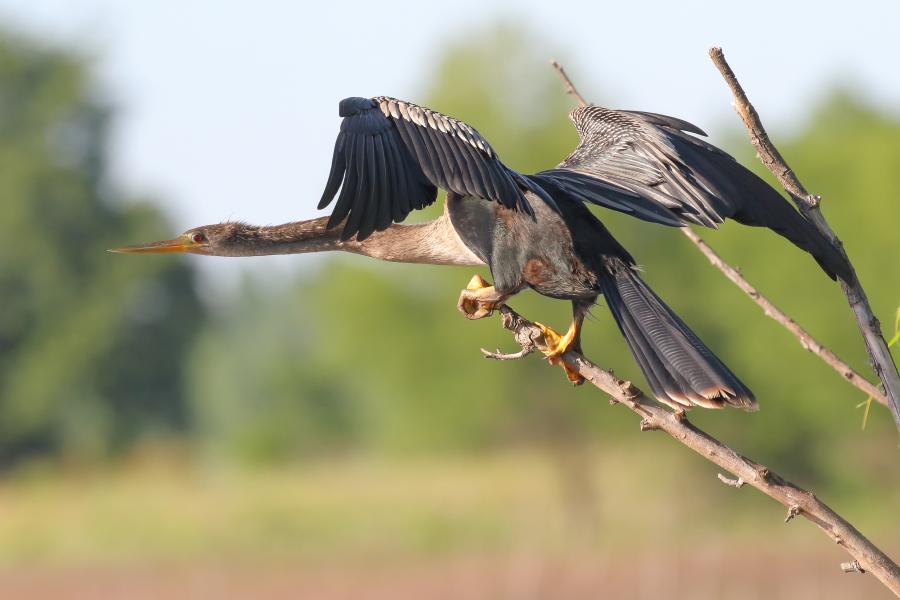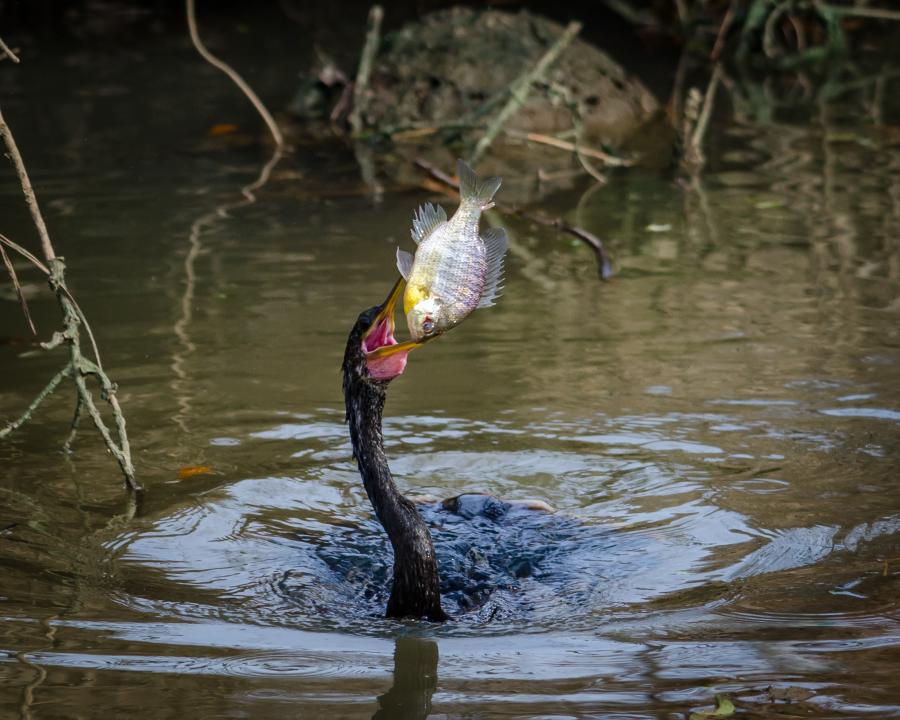SCIENTIFIC NAME:
Anhinga anhinga
OTHER NAMES:
Water turkey, snake bird, darter.
STATUS:
Breeder. Fairly common to uncommon in Inland Coastal Plain and Gulf Coast regions in spring, summer, and fall, but rare in winter. Occasional to rare in Tennessee Valley and Mountain regions in spring, summer, and fall. Low Conservation Concern.
DESCRIPTION:
Anhingas belong to Order Pelecaniformes, as do a number of other primarily aquatic birds (pelicans, cormorants, boobies, and frigate birds). The family Anhingidae includes several similar species referred to as “darters” which, as a group are distributed worldwide in tropical to warm-temperate climates.
Anhingas are relatively large birds, attaining lengths of 32 to 36 inches and wingspans of up to 48 inches. Adult anhingas usually weigh around three pounds and have long necks most often carried in an “s-shaped” posture. Their heads are small with long pointed beaks. Anhingas’ tails are long and loosely jointed with feathers which can be spread wide like a fan. Male anhingas’ plumage is greenish black overall but is accentuated by silver-gray plumes scattered across the upper back and a black crest on the head. Their wings are edged with long white feathers as well. Female anhingas are brown overall with lighter shades of brown on the head and neck, and juveniles are simply uniform brown.
Unlike most birds, especially aquatic species, anhingas do not produce oil to waterproof their feathers. As a result, their feathers quickly become saturated upon contact with water. This characteristic is believed to facilitate their deep diving feeding habits. On the other hand, this feature causes the anhinga to have little buoyancy. They often swim with only their heads above the water surface. Further, having feathers readily soaked to skin results in more rapid loss of body heat and hinders flight until the feathers dry. Anhingas are routinely seen with wings spread wide, allowing them to dry in the sun while their bodies warm. All of the anhingas’ flight feathers are molted as a group rendering the bird flightless for a period of time while the new feathers grow in.
DISTRIBUTION:
The anhinga is, for the most part, a tropical and subtropical species, but its range extends into warm-temperate areas as well. It is commonly found from Argentina in South America, throughout Central America, and in the southeastern United States from North Carolina to Texas. Its distribution appears to be limited by low daytime temperatures and lower intensities of sunlight. Individuals, usually subadult males, are sometimes seen as far north as the Canadian border during the summer months.
HABITAT:
Anhingas are closely associated with aquatic habitats, both coastal and freshwater, including lakes, marshes, swamps, mangrove swamps, large streams and rivers, shallow coastal bays, and lagoons. They seem to prefer bodies of water with shrubs or low trees along the shoreline in which they can sun themselves more safely than they can on the ground. Anhingas both roost and nest in trees over or immediately adjacent to water. They seem to select habitats having relatively sparse aquatic vegetation , thus facilitating diving and swimming during feeding or escape from danger.
FEEDING HABITS:
Anhingas are effective aquatic predators. They are not particularly fast swimmers, but use their quick, darting neck and sharp beak to capture prey. Anhingas feed primarily on fish, but aquatic invertebrates, insects, frogs, salamanders, small snakes, and amphibian eggs are eaten when available. They tend to focus on slower moving species of fish which they stalk underwater and in effect “spear” with a lightning fast strike of their long neck and slim pointed beak. Captured prey is taken to the surface, the beak is withdrawn, and the meal is swallowed head first.
LIFE HISTORY AND ECOLOGY:
Anhingas reach sexual maturity at about two years of age. In tropical and subtropical regions, breeding occurs year round when temperature and water level conditions coincide to make circumstances favorable. In the southeastern United States, however, most nesting takes place from March through May.
Anhingas are monogamous and pairs may use the same nest year after year. Courtship begins with the male anhinga soaring and gliding in display for the female and finally marking a potential nest site with leafy twigs. Further display by the male attracts the female to the nest site. The pair cooperates in nest building with the male gathering materials while the female constructs a platform nest. Nests are usually located on branches overhanging water or in the open top of a tree. Anhingas will sometimes appropriate and add to nests constructed by other species. Most nesting occurs in small colonies comprised either exclusively of anhingas or of a mix of this species with cormorants and/or herons.
Copulation occurs on the nest with the female then laying an egg every one to three days. Clutches range in size from two to six, but average about four oval-shaped, bluish-white to pale green eggs sometimes having brown speckles. Incubation takes 25-30 days with both the male and the female sharing in this duty. Male anhingas aggressively defend the territory surrounding their nest.
Newly hatched anhingas are naked and helpless. Initially, the parents feed the hatchlings partially digested, regurgitated food (mainly fish) dripped from their beaks into the chicks mouth. Older chicks reach deep into the back of the parents throat to feed. Chicks remain in the nest for about three weeks, after which they perch on adjacent limbs while still being cared for by the parents. Fledging occurs at about six weeks of age, but the young remain with the parents for several more weeks before achieving their independence.
REFERENCES:
“ADW: Anhinga anhinga: Information”
https://animaldiversity.org/accounts/Anhinga_anhinga/
“American Anhinga or Snake-Bird”
https://www.audubon.org/field-guide/bird/anhinga
“Anhinga Species Account – Florida Breeding Bird Atlas”
https://myfwc.com/wildlifehabitats/profiles/birds/waterbirds/anhinga/
“Nature Works – Anhinga”
Http://www.nhptv.org/natureworks/anhinga.htm
AUTHOR:
John S. Powers, Wildlife Biologist, Division of Wildlife and Freshwater Fisheries







